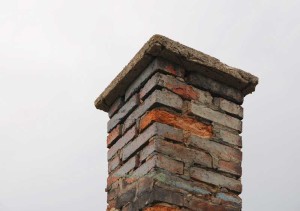As we have recently learned too well, water can be as destructive as fire; our hearts still go out to those who suffered Sandy’s devastation. For chimneys, water can be more damaging than fire, and it does not have to reach flood level to cause it. Water is what cracks chimneys and warps flues, stretching and shrinking as they heat and cool.

Brick spalling caused by water damage
There are a number of possible contributors to water in your chimney:
- mortar deterioration
- a cracked chimney crown
- leaky roofs and flashing
- a missing or rusted chimney cap
- a shifting foundation
- gas condensation in improperly sized flues
Even the simple passage of time contributes to water permeating porous materials and causing them to crumble.
Improper fits of flues to fireplaces is a surprisingly common problem, usually first appearing as insufficient updraft. Heated air remains in the chimney to cool and condense on the flue, leaving water to steadily cause unseen damage. If homeowners are having problems with smoky fireplaces, their best bet is to have a chimney sweep inspect the whole chimney system for the root cause.
Timely intervention is critical to preventing extensive water-caused damage that can be very expensive to fix. Homeowners who have not yet thought of spring inspections should schedule them before warmer and wetter weather arrives. Repair or replacement now can be key to keeping expenses down and safety up, since water-damaged chimneys can be unsafe to use and expensive to fix.
In a never-ending carousel of cause and effect, water ends up being both in the case of chimney damage. Once it starts cracking and rusting things, water gives itself easier and easier access to the chimney. It is only sensible to shut it out before it works its way farther and farther in, because that gives rise to a flood of problems.
